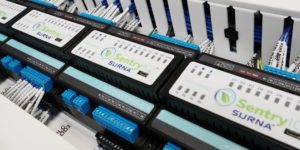We’ve often referred to the importance of HVAC systems to every layer of the cultivator’s business. One of the complications with selecting the right designer or technology is that few cultivators are mechanical engineers. This really complicates the process of deciding which provider or technology is best for your facility. When it all sounds good, how do you make the right decision for your grow? The truth is, there are a number of technologies that can successfully manage the climate in an indoor facility. The trick is understanding the pros and cons of each and working with a mechanical design partner who can clearly articulate them to help you make an informed decision.
Which Team Are You On?
As it relates to managing humidity in cultivation facilities, there are essentially two options: standalone dehumidification, where humidity control is decoupled from temperature control, and integrated dehumidification, where cooling and dehumidification are controlled with the same equipment. (For the purposes of this discussion, we are assuming that ventilation is not being used as a primary means of managing humidity). Team Standalone generally consists of DX air conditioning units (standard rooftop units, split units, mini-splits) or 2-pipe chilled water. On Team Integrated are integrated hot gas reheat units and 4-pipe chilled water systems.
For the purposes of this discussion, we are only focused on dehumidification performance and functionality of each approach, and not the myriad of other pros and cons associated with each option. (This is a blog, not a dissertation, and frankly it’s going to go a little long as it is. We hope you have a few minutes).

To better understand the benefits and drawbacks of each approach, it’s helpful to understand how each type of system tackles dehumidification. In both approaches, when the cooling is in operation, dehumidification is also achieved as a byproduct of cooling. When room air passes over the cooling coil, both sensible and latent heat are removed from the room. Sensible heat is the direct heat present in the space, produced primarily by lighting in cultivation facilities. Its removal results in a decrease in temperature in the room. Latent heat is associated with dehumidification—when the warm, humid room air passes over the cooling coil, water condenses from gas to liquid, where it can be drained away. That phase change from gas to liquid produces heat (or BTU’s), which is also absorbed by the cooling coil.
In standalone systems, there is no direct humidity control. Simply stated, you get what you get as a byproduct of the cooling process. This means that temperature and humidity are managed independently, and additional dehumidifiers must be utilized to manage humidity to a specific setpoint. This is especially true during lights off when there is little or no sensible heat load forcing the cooling system to run. In integrated systems, humidity and temperature control are managed simultaneously. Sensible to latent heat removal ratios within the system are managed through modulation to ensure that temperature and humidity targets are met.
Effect on Energy
If electrical infrastructure and energy use were the only considerations, well designed modulating systems would likely win in most facilities. For connected load, standalone systems generally have far greater electrical infrastructure requirements because some compressors and cooling coils are dedicated to cooling and some are dedicated to dehumidification, resulting in a certain amount of doubling up. When the same compressors and cooling coils can be used for both purposes, as in modulating systems, connected load decreases significantly.
Even with extremely energy efficient dehumidifiers, electrical use may be lower in an integrated system as well. When dehumidifiers run, like cooling coils, they also absorb both latent and sensible heat. The sensible heat is returned right back to the airstream, but the latent heat associated with the dehumidification process is converted to sensible heat. This heat is returned to the airstream as well, where the cooling system then has to remove the sensible heat again to cool the room. This is why the air coming out of your dehumidifier feels so hot. This means that energy is being used to remove the latent heat, and then more energy is needed to remove the sensible heat created by the process. Essentially, doubling up and using energy to remove the same heat twice.
With modulating systems, the latent heat is absorbed directly into the cooling coil and is then rejected outside, requiring no doubling up of cooling. It should be noted that modulating systems also absorb sensible heat as a byproduct of dehumidification, so they must have a reheat feature to avoid overcooling the room during lights off when operating in dehumidification mode. In modulating systems, the best and most energy efficient designs utilize hot gas reheat (as in refrigerant based systems), or heat recovery (as in chilled water systems), where the sensible heat removed by the dehumidification process is returned to the room, as opposed to using a secondary heating source for reheat.
Controls
Controls in modulating systems are far more complex than those in standalone systems. Standalone systems can be controlled with simple analog or digital thermostats and humidistats mounted in the room (keep them out of direct light by using a shade or an aspirated box to ensure correct readings), or more sophisticated systems as desired. Modulating systems require modulation of fan speeds, refrigerant or water volume, pressures and temperatures, and sophisticated valving monitoring of HVAC equipment status. This level of sophistication can be both a blessing and a curse.

The downside is the greater expense for controls of a modulating system. The upside is the extreme visibility the cultivator has into the operation of his or her climate control system, which allows for immediate detection and faster diagnosis of potential equipment problems, immediate detection and faster response and correction of any failure to meet temperature and humidity setpoints, and significant opportunities for optimization of both energy use and overall performance.
Unfortunately (although there are a few), most controls companies in the cannabis space don’t have the ability to truly control a modulating system and all of its functionality. Most commonly, they will provide a user interface that allows you to adjust setpoints and tell you what the parameters in the room are, but they aren’t actually programming valves and sequences for every step that needs to be taken to properly modulate more sophisticated systems. If you’re considering a modulating system, make sure you ask a lot of questions about the controls requirements so there are no 11th hour surprises, and make sure your controls vendor really understands what they are committing to controlling.
Performance in the Grow
As previously mentioned, assuming it’s properly designed and implemented, any type of mechanical system can maintain acceptable parameters in a grow facility. The differences are really in the “How?” which we explained above, and the “How well?” which we’ll address here.
With standalone systems, the controls are typically on/off, which means that as soon as the temperature or humidity drifts out of spec, the system engages, cools or dehumidifies to below set points, and then turns off. The result is potentially using more energy than absolutely needed to perform cooling and dehumidification functions (by overshooting targets or rapidly cycling the system).
From a performance standpoint, this usually means that the trend lines for temperature and humidity look more like a sawtooth than a smooth line, where the room is essentially bouncing up and down off setpoints. Some cultivators are accepting of this performance and a wider tolerance, and some prefer much tighter tolerances and trend lines. This isn’t to say that a standalone system won’t keep your grow within acceptable parameters, just that the temperature or humidity might fluctuate by several degrees or percentage points throughout the day.
With modulating systems, specifically because everything modulates, the system doesn’t use more energy than it needs. As soon as something begins to drift out of spec, the system responds incrementally to straighten the trend line back out. This results in much tighter tolerances to setpoints, and less overall energy use. Cultivators who prefer very tightly controlled grow room parameters will typically prefer the performance of a modulating system.
Cost
We probably could have led with this one, as it’s usually the first question we get asked when our clients are planning a cultivation facility. First costs for modulating systems are generally going to be anywhere from 30-60% higher than for standalone systems depending on the bells and whistles you opt for. However, in many cases those costs can be offset by a reduction in electrical upgrade costs so be sure you’re considering all of the variables when comparing costs. If first costs are a primary consideration, as they so often are, standalone systems will likely be the first choice. However, if long term performance and operating costs are high on the priority list, and the budget allows, modulating systems are an excellent investment.
If you are ready to discuss your future design plans, contact us!

